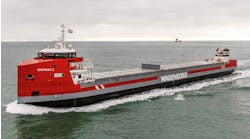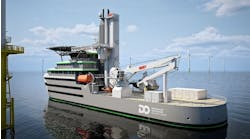The concept of packaging electrically-driven, azimuthing propulsion units in self-contained pods was developed by ABB, Kvaerner-Masa Yards, and the Finnish Board of Navigation in the late 1980s, with ice-breaking vessels in mind. However, the success of the hydrodynamically-efficient propulsion units, which provide vessels with greatly improved maneuverability, has resulted in their acceptance in a much wider range of applications. An early small unit of 1.5MW for a seaway service and supply vessel was followed by two 11.4MW units for the 16,000-ton Arctic tankers, the MT Uikku and the MT Lunni, in the mid-1990s. From there, it was a small jump into the cruise ship market. These days, almost all new ships of this type are being built with podded propulsion units.
ABB, Kvaerner Masa, and a third partner, the Italian shipyard, Fincantieri, formed a company to market the technology using the name ABB Azipod in 1997. Anders Backlund, who has responsibility for sales and marketing of the units, considers his main challenge now is coping with the rapid growth in the market. "There had been a reluctance to accept electrically-driven motors as the prime form of propulsion in some parts of the shipping industry, but that is being eroded now, and the market is really taking off," he said. Backlund sees the units becoming the first choice means of propulsion in every sector of the offshore and marine market in the future.
The downturn in the offshore sector experienced over the last two to three years has meant few units have so far been sold for what Backlund considers is an ideal application - semisubmersible vessels for drilling and production, construction support, accommodation and so forth. However, with an upturn in new-building and upgrading expected, business is likely to be brisk in this sector of the market.
One of the inherent problems faced by mechanical thrusters is the design of the gears and power transmission system to manage the high levels of torque generated by rapid changes in speed and direction. Electrically-driven podded systems are not affected by this sort of problem. The speed of the motor is controlled in a smooth fashion by a frequency converter, with full torque available in either direction from zero to nominal speed.
A specific challenge presented by the offshore market is the requirement for units that can be easily removed and re-installed at sea for repair and maintenance - a 7-8 MW unit typically weighs around 100 tons. According to Backlund, ABB Azipod has recently addressed this need and is now in a position to offer this capability.
Podded units have already been supplied into this market, but by ABB Azipod's main rival, Mermaid (a joint venture between Alstom and Kamewa). Last year, US-based Transocean Sedco Forex ordered twelve 7MW units to be fitted to three new-build drilling rigs for use in West Africa and the Gulf of Mexico. The Sedco Express, Cajun Express and the Sedco Energy each weigh around 6,000 tons and are designed for drilling in up to 6,000 ft of water. As well as providing the dynamic positioning capability, the podded propulsion units will enable the rigs to make 10 knots under their own power.
Backlund sees Mermaid providing the main competition to his company. However, he is confident of retaining the upper hand with several new developments in the pipeline, which he expects to be able to announce later in the year.


